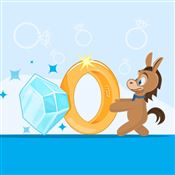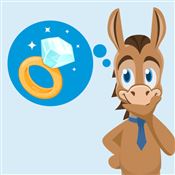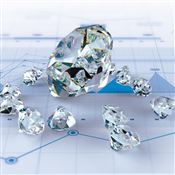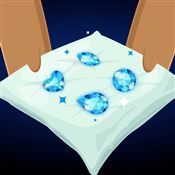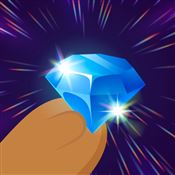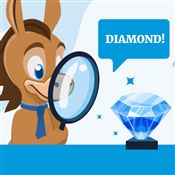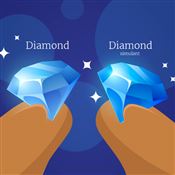Average Diamond Size for Engagement Rings
The average diamond size for engagement rings is just around 1 carat. But what if you don't have the budget to meet it? Here's what you can do.
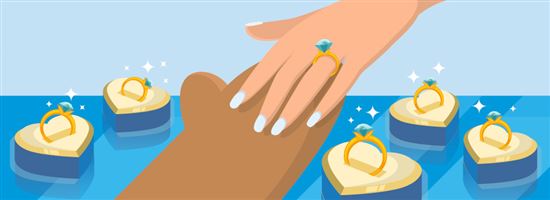 |
No one wants to disappoint with a tiny rock.
That's why many engagement ring shoppers get super worried about the diamond size.
You don't want to make your fiancé insecure with a diamond that's way smaller than their friends'. But you're working within a budget, and you can't just pick a giant stone that might look tacky.
Browse Diamond Inspiration Gallery
So to help you find the perfect ring, CreditDonkey did a study into what the average size is. But if you can't meet it, don't worry. You'll also learn some good tips on how to get the best value and how to make a diamond look larger.
What is the Average Carat for an Engagement Ring?
In the United States, the average size of an engagement ring center diamond is between 0.8 and 1.2 carats. This can go up or down depending on your age and where exactly you live.
So to answer this question better, CreditDonkey did an independent survey across major cities in the U.S. Here's what we found:
- Los Angeles: 0.83 carat
- New York City: 1.45 carat
- Chicago: 1.29 carat
- Dallas: 1.04 carat
- Miami: 1.08 carat
But if you're outside the U.S., you might notice that center stones are smaller in your area. In Europe, China, and the U.K., couples usually opt for a 0.5-0.6 carat diamond. It's even smaller in Japan at 0.3 carat.
The numbers usually get bigger for older buyers, since they've had more time to save for a bigger stone.
So What Does This Mean? Does the Average Matter?
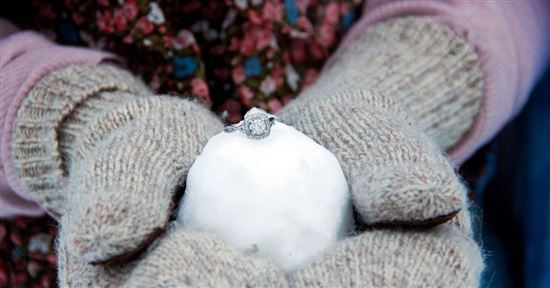 |
In our opinion, you shouldn't let the average diamond size influence your budget.
The most important thing is to get something you can afford. The ring is a symbol of your love, commitment, and promise of a future together. And you don't want to start that future in debt. So don't go into debt trying to reach the average if it's truly out of your budget.
In fact, you can just upgrade to a bigger stone once you've earned enough. Upgrades are actually a great way to celebrate milestones in your relationship. They're also special reminders of the victories you've had as a couple.
Browse Engagement Rings for Every Budget
Read: How Much Should You REALLY Spend on the Engagement Ring
Another thing people unwittingly do is sacrifice quality just to hit the desired goal.
For example, maybe someone has a budget of $3,500 but wants to reach the average of 1 carat. Sure, you can buy a 1-carat diamond for $3,000 and have some left for the setting. But it's going to be a very poor quality diamond that looks dull. It's much better to buy a smaller diamond with an excellent cut.
In the next section, we give you some tips on how to get the best value so you avoid that mistake.
Finding the Perfect Carat Size
If the average doesn't matter, how do you know which diamond size to get? Again, the ideal size boils down to your own budget and taste. After setting your budget, consider three things: finger size, personal style, and lifestyle.
Finger size. A diamond won't look the same on different finger sizes. Naturally, it will look smaller on larger hands and wider fingers. This diamond size chart may help you visualize how a carat size might look on your finger.
Personal style. Do you like wearing flashy things and standing out? Or do you prefer minimalist looks? Your personal style can help decide if you'd be comfortable wearing a big rock.
Lifestyle. If you work with your hands a lot, a big stone might get damaged easily. Consider smaller stones or more protective settings instead.
Where to Buy an Engagement Ring Online?
The best place to buy an engagement ring depends on what you're looking for.
Search for Beyond Conflict-Free Diamonds
Shop for diamonds at Brilliant Earth, a CreditDonkey recommended partner for socially-responsible diamonds.
Getting the Best Carat Value For Your Budget
Think your budget's too small for the size you like? These tips can help you get the biggest stone possible with your budget.
- Always get the best cut possible.
The quality of cut decides how sparkly your diamond will be. So if you sacrifice cut for carat, you'll end up with a big but dull (or ugly) stone. And when a diamond is well-cut, it can even look bigger thanks to its intense sparkle.This is why you should never skimp on cut. It's in cut, not color or clarity, where the extra money will make a huge difference in appearance. So before you shop for your ring, it's important you read our detailed article on cut first.
Did you know? Sometimes, gem cutters sacrifice cut quality just to hit the 1-carat mark. This often means that a lot of the diamond's carat weight is hidden in the depth. You're spending extra to have 1-carat on paper that's really wasted on something you can't see. - Look for a diamond slightly under the magic numbers.
The magic numbers are every 0.5 carats. At these weights, diamond sellers can fetch significantly more. If you go just below a magic number, you can pick up a diamond for as much as 25% less.For example, a VS2 H Excellent cut diamond that is 1 full carat costs around $5,800. But keeping all other C's the same and dropping the carat weight down to 0.9 will also drop the price down to $4,800. And nobody is going to be able to tell the size difference.
Tip: Still don't believe that no one can tell the difference? Here are some numbers: a 1-carat round diamond is around 6.4-6.5 mm in diameter. But a 0.9-carat round diamond measures 6.2-6.3 mm. This is literally just a difference of 2 mm (equivalent to the thickness of a piece of paper), but you can save a lot. - Get a diamond lower in clarity.
Clarity is the best area to save some money on. Most flaws are too small to be seen by the naked eye. VS2 diamonds are the best value, but you can even find eye-clean SI1, SI2, and I1 diamonds. - Pick a yellow gold or rose gold band.
The setting itself isn't cheaper. But they pair well with lower color diamonds, like a J, that could cost thousands of dollars less. You can then use that towards a bigger diamond if you wish.Check out how beautiful a J diamond or K diamond can look in a warm-toned setting.
Tip: Medium-strong fluorescence can improve the color in lower-grade diamonds (I and below). Fluorescence is a natural phenomenon where the diamond glows blue under UV light. It can cancel out some of the yellow in lower-colored diamonds and make them whiter. - Switch to lab diamonds.
Switching to a lab diamond can get you a way bigger stone for your budget. With a budget of $5,800, you can either get this 1.03 carat natural diamond or this 2.08 carat lab diamond. If you don't mind its origin, then a lab diamond is the easiest way to get a big center stone.Our lab diamond vs natural diamond comparison might help you decide if going lab-grown is for you.
- Shop online.
Online retailers offer much better pricing because of their low overhead. In our study, we found that buying a diamond online costs as much as 40% less than at traditional, big-name diamond retailers (for diamonds with the same characteristics).If you need a headstart finding reputable stores, check our online diamond retailers list. Trustworthy online retailers offer high-quality images and videos of their gems so shoppers know what they're getting.
Related: What Affects Diamond Prices and How to Get the Maximum Value
How to Make a Diamond Appear Larger
You've looked at all you can do to save, but still have trouble reaching the average? Don't worry. There are some options to help make a smaller diamond appear larger.
- Halo settings make a diamond larger.
One of the most popular settings is the halo, which has a ring of small diamonds around the center diamond. This setting gives off serious bling and makes it look as if the diamond is huge.A bezel setting also works the same way by increasing the overall diameter (as long as the bezel is not so thick that it makes the diamond look smaller).
Watch out: The worst setting for making a diamond appear larger is the 3-stone or side stones. Thick heavy bands also kill a smaller diamond. - Consider a fancy-shaped diamond.
Another favorite suggestion is to go for another shape. Not only do fancy-cut diamonds often appear larger than they are, they're cheaper than round, too. And plus, they are more unique and will appeal to girls who like to stand out in a crowd.Pear and marquise shapes look the largest. Just stay away from the asscher cut, which has the smallest surface area of all shapes.
![1 Carat Diamond - Different Shapes Illustrated © CreditDonkey 1 Carat Diamond - Different Shapes Illustrated]()
1 Carat Diamond - Different Shapes Illustrated © CreditDonkey - Thin bands make a diamond larger.
The thinner the band, the larger the center diamond will appear. Knife-edge bands give the illusion of a very thin shank. Another good setting is to go with a thin pavé band. Setting it in a band of small diamonds will make the center stone pop. - Cluster settings give the illusion of a huge diamond.
This is when a cluster of smaller diamonds make up the center. So from farther away, it looks like one big diamond. This is a relatively inexpensive way to get a large center.
Bottom Line
The size of the diamond is such a personal choice. If you can meet it - great! If not, don't let the number scare you or make you think you need to spend beyond your means. It's most important that the ring is in line with your budget. Also don't make the diamond size your absolute top priority at the expense of beauty.
Lastly, remember - the ring is a symbol of love and commitment. There are many ways to show that without spending a fortune - whether it's putting in the effort to plan an unforgettable proposal, or designing the perfect ring unique to her style.
These are all more meaningful gestures than simply buying a diamond that matches the national average.
References
- ^ Brides, This Is the Average Ring Size for Men and Women, Retrieved 12/14/2020
- ^ CreditDonkey, Average Engagement Ring Cost May Shock You, Retrieved 12/14/2020
Write to Anna G at feedback@creditdonkey.com. Follow us on Twitter and Facebook for our latest posts.
Note: This website is made possible through financial relationships with some of the products and services mentioned on this site. We may receive compensation if you shop through links in our content. You do not have to use our links, but you help support CreditDonkey if you do.
|
|
| ||||||
|
|
|





